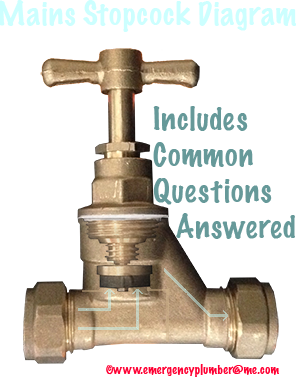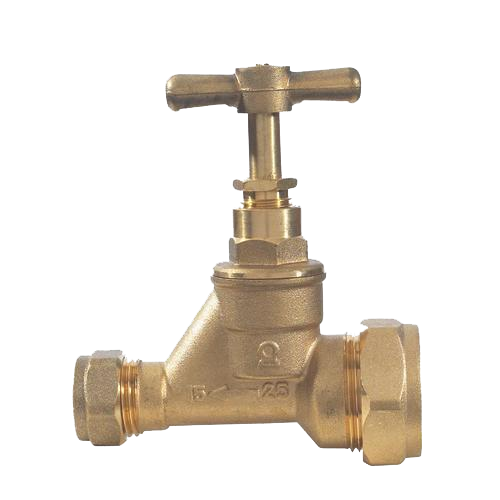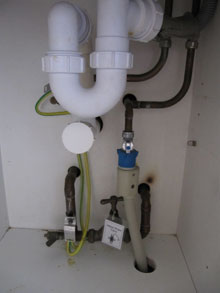Main Stopcock Problems & Information Solved

- What is a Main Stopcock?
- How many stopcocks should there be in/outside a house?
- Where Can I locate my Mains Stopcock?
- My stopcock in not under my sink, where can I find it?
- Can I do anything to look after my Main Stopcock?
- My Main Stopcock is leaking, Help?
- Do I require a main stopcock key to turn my water off?
- My Main Stopcock is jammed what can I do?
- How do I replace the Main Stopcock?
- How do I turn off your water using the Main Stopcock?
- Is my water company responsible for the external Stopcocks?
- Can my house insurance be affected by the condition or use of my Main Stopcock?
What is a Main Stopcock
A main stopcock is a type of valve used to completely stop the flow of water by using a handle, spindle and a rubber washer that pushes up against a rounder brass opening. The mains stopcock comes from a name given to the stopcock to stop water many years ago, but in recent history of plumbing, the stopcock has also been known as the stop tap, mains water shut off valve or the stop valve so that the name has a better sound to it.
How many stopcocks should there be in/outside a house?
 There must have at least one main stopcock within the property, you will most certainly find an external stopcock just outside the boundary of your home and sometimes within the boundaries. The mains water stop tap outside the boundaries is sometimes share amongst other homes depending on the age of the house where newer properties have the own stop valve. Always be aware that the stop tap should never be mixed up with the gate valve or the Isolation valve as these valve are completely for different uses.
There must have at least one main stopcock within the property, you will most certainly find an external stopcock just outside the boundary of your home and sometimes within the boundaries. The mains water stop tap outside the boundaries is sometimes share amongst other homes depending on the age of the house where newer properties have the own stop valve. Always be aware that the stop tap should never be mixed up with the gate valve or the Isolation valve as these valve are completely for different uses.
An outside stopcock is a form of inline valve that works by rotating a stop or a plug within the chamber to stop the flow of water. This is normally activated by a small handle or a rectangular projection for which a stopcock key must be used. It is advised when turning the outside mains water stopcock that you use only the correct tools as the incorrect tools can damage the stop valve.
When the handle or key is turned clockwise, the valve is closed and when turned anti-clockwise the valve is open. Some mains water stopcocks have a screw device, which requires multiple turns, whilst others are a quarter turn. A newer device on the market for in the home is the remote or automatic stopcock. The automatic stopcock works in much the same way, but with an electronic actuator working on remote or activation by a sensor.
Where can I located my Main Stopcock
The main stopcock valve should be located under the sink other than the mains water stop valve locate outside the boundaries. Martin Smith an emergency plumber believe a shut off valve or main stopcock is a very important valve and should be made very familiar. Martin also believe the stop valve should also have a tag shower that it is the mains water stopcock in order to let those know about how to turn there stop valve off. This will save plenty of costs when it comes to a plumbing emergency such as a leaking tap. Needless to say in accordance to Murphy’s Law, these things happen when it most inconvenient, so a little preparation goes a long way.
My stopcock in not under my sink, where can I find it
Depending on the type of home, age of your home and even the location of your home. Your stopcock could be anywhere. It now is a requirement that homes must have at least one stopcock, but in a particularly old home that may not be the case. In the grand majority of all cases the home will have one and it normally sits close to the water input from the main supply. Now a good place to start is in the kitchen and quite a few people will find the mains water stopcock in the kitchen under the sink. Some people, it could be elsewhere in the kitchen under a cupboard, in a pantry, in a garage or even behind a panel near your boiler. Some owners of older properties can find your stopcock under floorboards or in bathrooms. Properties like terraced usually have a utility cupboard in the hall or the lounge. Remember apartments, flats and shared properties can be very different and some have stopcocks within the dwelling and some on the shared landings and halls.
Can I do anything to look after my Main Stopcock
As with any mechanical device, time can be unkind and eventually if it is not looked after or used, it will become unusable and need replacing. In the home, if all goes well, the main stopcock should need to be used little or hopefully not at all. This poses a problem, as time marches on the stopcock can seize, leading to the stop tap becoming impossible to use or the unit leaking and causing the problem it is there to help contain. In saying all this, we can help stop this happening, with some easy, regular servicing.
Now you know how to find the main stopcock, if you can make sure it is easy to turn, if so, on a regular occasion a little turn once in a while shall ensure smooth operation. If the Stopcock is a little stiff to turn apply some easing oil and allow soaking before working the handle back and forth until it eases. If the tap will not turn at all and easing oil makes no difference then the main stopcock may either need to be replaced or the stop valve may just need taking apart, cleaning and regressing up so that it is just like new again.
My Main Stopcock is leaking, Help!
If the main stopcock is leaking from a gland, then you may just be able to tighten it up at the gland to either slow the leak down and hopefully stop the water leaking. If the mains water stop valve is leaking from the main body then this becomes a little more tricky and you will require an emergency plumber. The plumber will most likely take the body off and place PTFE around the threads to enable a new seal to the stop valve. If the stop valve has too much PTFE then the chances are that the stop tap body at the thread will split open at the brass wear. If the mains water stopcock is leaking from the nuts then you can either use PTFE or plumbing paste.
Do I require a main stopcock key to turn my water off

Long Stopcock Key
A Main Stopcock key is normally a metal tool which comes in various lengths. This tool allows you to reach the normally covered rectangular turning key and open or close with a clock or anticlockwise turn. Generally if the turning T-bar is in line with the pipe flow, it is open and across is the closed position.
My Main Stopcock is jammed, what can I do
Mains water stopcocks are best used sparingly. If your stopcock won’t turn off with the use of little elbow grease then you may need to find a pair off grips and turn off in the clockwise position only. You will only need this when your house is in need of a DIY plumbing situation or your in a plumbing emergency situation. Most or all main stopcock are made out of a metal brass or some of the older ones are made out of metal and lead pipe. Most stop valves bung up of dirt and muck and after time become very stiff. After a time the stop tap looses it’s grease due to age. A cure to loosening the dirt and grime within the stopcock can be cured a little by just moving back and forward or opening and shutting.
How do I replace the Main Stopcock Valve
 To replace the main stopcock valve you will First of all need to turn off the mains water stop valve from outside the home boundaries or simply freeze the stopcock with either a pipe freezing kit or asking the plumber to use an electric pipe freezing machine. If turning the outside mains stopcock you may need an outside stopcock key. If you struggle to turn the water off then it is best you get in touch with the water utilities company. Once the date has been turned off you can turn the kitchen tap on to make sure the water is off. Make sure you have a towel or a wet vacuum to dry up any loose water coming out. Undo both nuts on the main stopcock and take the stop tap away. Sometime if the stop valve isn’t loose then you may have to either disconnect further pipework or cut some pipework out in order to have enough play to fit a new stopcock in. It is very important to make sure that the stopcock goes in the same direct as the water flow. Once the mains water stop valve has been fitted it is very important to leave about 5 to 10-minutes to check for any slow leaks. If you find some slight leaks then it may be a good idea to use some plumbing paste of some PTFE.
To replace the main stopcock valve you will First of all need to turn off the mains water stop valve from outside the home boundaries or simply freeze the stopcock with either a pipe freezing kit or asking the plumber to use an electric pipe freezing machine. If turning the outside mains stopcock you may need an outside stopcock key. If you struggle to turn the water off then it is best you get in touch with the water utilities company. Once the date has been turned off you can turn the kitchen tap on to make sure the water is off. Make sure you have a towel or a wet vacuum to dry up any loose water coming out. Undo both nuts on the main stopcock and take the stop tap away. Sometime if the stop valve isn’t loose then you may have to either disconnect further pipework or cut some pipework out in order to have enough play to fit a new stopcock in. It is very important to make sure that the stopcock goes in the same direct as the water flow. Once the mains water stop valve has been fitted it is very important to leave about 5 to 10-minutes to check for any slow leaks. If you find some slight leaks then it may be a good idea to use some plumbing paste of some PTFE.
How do I turn off the water using the Main Stopcock
Firstly you must locate the Main Stopcock (see Question 3 where can I locate my Main Stopcock). Once you know where the mains water stop valve is, then you will need to turn off clockwise until completely closed. Turn on the taps in the sinks and bathrooms to remove any water remaining in the household system.
Is my water company responsible for the external mains water stopcock
Is my water company responsible for the mains water stop valve is a common question and one that the answer has recently changed. The water utility companies provide two main piped services to your home. The first is the delivery of fresh water. The second is the removal of waste water from both sewage and drainage. In the past it has been unclear as to who is responsible between the homeowner/landlords and the Utility Company for which of the piping and associated taps within each boundary. Very recently the government and utility companies have moved to clarify this as follows.
Delivery of fresh water. In the case of a detached property, the “water main” normally follows the route of roadway and a “communication pipe” branches from this to the property. This terminates in a stopcock within the pavement. A “supply pipe” comes from this to your property and it is at the boundary of your property that the responsibility of the Utility company stops and yours begins.
In the case of a semi-detached or terraced property up to the property boundaries is the same and the responsibly of the Utility company. Beyond that a “Common supply pipe” is shared by all homeowners within the boundary. Finally a “Branch pipe” is the individual homeowner’s responsibilities. So the answer to stopcocks within the boundary of your property are your responsibility and outside of that on the public areas is the responsibility of the Utility Company.
Is my house insurance affected by the condition of my Main Stopcock
In 2010 insurance companies in the UK paid in excess of £900m in claims relating to burst pipes. A significant leak can cause up to 2,200 GALLONS of water to leak over the course of one day. With damage ranging from furniture and personal belongings to ceilings, walls and electrics, in the most severe cases even structural damage can be caused. Taking all of this into account, it is clear that Insurance companies are looking to limit the cost of these damages and whilst it is not widely published, if excess damage is caused which could have been prevented by an unusable device such as the Main Stopcock in your home. This could affect your claim. Many people are not aware, but burst pipes are not always included as cover on your home insurance policy, some insurers make it an added option, whilst others will not cover at all. In addition to this, not every policy covers the repair of the burst pipe itself and/or the trace and find portion of the work. This means that whilst the water damage maybe covered, the pipe or any damage the plumber may have to cause to find it and get to it, can be left to you to pay for. Taking all this into account it is advisable to firstly check your policy, secondly, find and make sure your main stopcock works, look after the stopcock by regular checks and if needs be, oiling and finally protect yourself from frozen or damaged pipes especially in the winter.
As with any plumbing DIY, it is important that you are competent in your abilities, sometimes fixing your own stopcock does not always go to plan and the help of a professional plumber is needed. A report by an emergency plumber London found this to be true and may be a lesson to those wondering what may happen.
If you have a problem like this and in need of an emergency plumber then please feel free to give us a call. If you a plumber and would like to register with us then please us an email at emergencyplumber@me.com but most importantly, keep your mains stopcock save.

